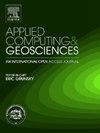利用机器学习对佛罗里达州中西部进行地陷敏感性分析
IF 3.2
Q2 COMPUTER SCIENCE, INTERDISCIPLINARY APPLICATIONS
引用次数: 0
摘要
本研究考察了应用机器学习进行天坑分类和预测的可行性和准确性,并将结果用于佛罗里达州中西部的自动天坑敏感性测绘。开发了两阶段加工流水线。在第一阶段,我们评估了五种典型机器学习算法的预测能力:随机森林(RF)、逻辑回归(LR)、k近邻(KNN)、支持向量机(SVM)和多层感知器(MLP),并选择了表现最佳的模型。然后,在该过程的第二步中,选择表现最好的模型来开发天坑敏感性图(SSM)。从收集到的地理空间数据中得到9个特征层,并将其作为条件变量。利用一些统计指标和受试者工作特征曲线来评估模型的准确性。结果表明,该模型预测能力最强,ROC值为0.984。利用RF模型绘制了敏感性图,并将研究区划分为高敏感性区(H)和低敏感性区(L)。利用混淆矩阵(Confusion Matrix, CM)和Matthews相关系数(Matthews Correlation Coefficient, MCC)对地陷敏感性图的分类结果进行了验证。我们提出了一个预测研究区域天坑分布的模型,我们模型的输出与佛罗里达州应急管理部门先前创建的天坑危害图一致。这项工作可以帮助政府、社区和土地管理者制定减轻灾害和土地退化的计划。本文章由计算机程序翻译,如有差异,请以英文原文为准。
Sinkhole susceptibility analysis using machine learning for west central Florida
This study examined the feasibility and accuracy of applying machine learning for sinkhole classification and prediction and using the results in automated sinkhole susceptibility mapping for west central Florida. A two-stage processing pipeline was developed. In the first stage, we assessed the predictive power of five exemplary machine learning algorithms: random forest (RF), logistic regression (LR), k-nearest neighbor (KNN), support vector machine (SVM), and multilayer perceptron (MLP), and select the best-performing model. The top-performed model was then chosen to develop a sinkhole susceptibility map (SSM) in the second step of the process. Nine feature layers were derived from the collected geospatial data and utilized as conditional variables. Several statistical metrics and receiver operating characteristic curves were utilized to evaluate the accuracy of the models. The results showed that the RF model, with a ROC of 0.984, had the highest prediction capability in the research area.
We generated a susceptibility map using the RF model, and the study area was classified into high susceptibility (H) and low susceptibility (L) areas. Confusion Matrix (CM) and Matthews Correlation Coefficient (MCC) were used to confirm the results of the sinkhole susceptibility map's classification. We present a model that predicts sinkhole distribution in the study area, and the output of our model is consistent with the sinkhole hazard map that the Florida Division of Emergency Management had previously created. This work can assist the government, community, and land managers in creating plans for mitigating hazards and land degradation.
求助全文
通过发布文献求助,成功后即可免费获取论文全文。
去求助
来源期刊

Applied Computing and Geosciences
Computer Science-General Computer Science
CiteScore
5.50
自引率
0.00%
发文量
23
审稿时长
5 weeks
 求助内容:
求助内容: 应助结果提醒方式:
应助结果提醒方式:


